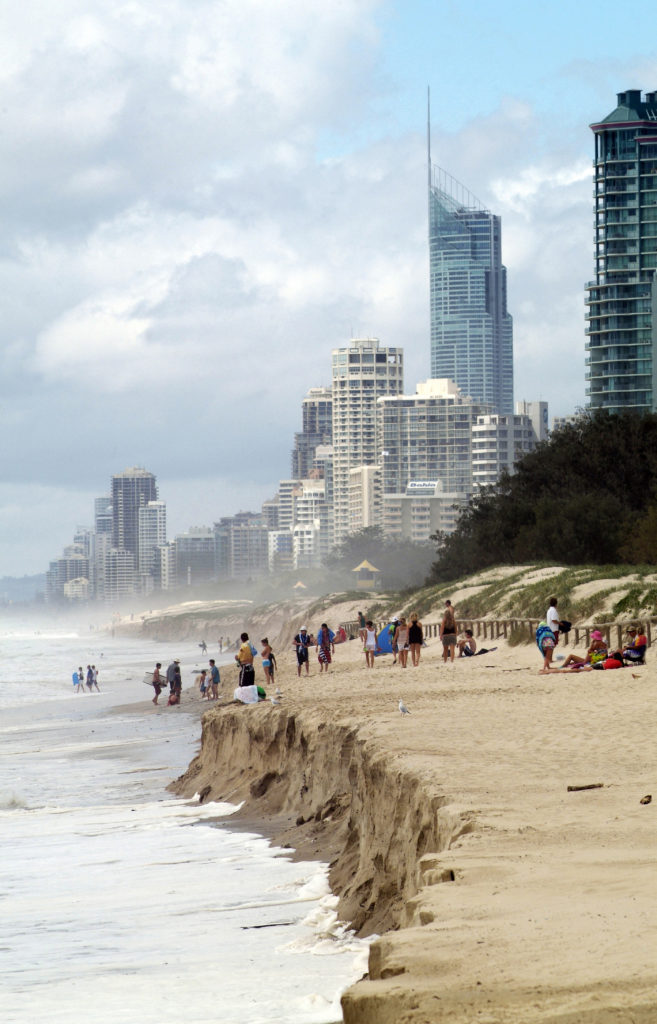Australian Vulnerability Profile

Gold Coast, Queensland, Australia. Storm ravaged beaches at this popular tourist resort. 2008 photo by Bruce Miller
Natural hazards lead to disasters if they intersect with a society which is exposed and vulnerable. Prevailing predominant approaches to disaster risk assessment and management place most effort on quantifying the characteristics of the hazard and mapping exposure; with vulnerability largely ignored or superficially considered. Yet we know that an increasing population and the decisions about where people, assets and infrastructure are placed, and how we live our lives (e.g., becoming increasingly dependent on optimised highly-interconnected systems) are leading to increased exposure and vulnerability. These dynamic and systemic causes of vulnerability are the least understood dimensions of disaster risk, and there are few approaches and capabilities to address this.
Our project explored the systemic risks, root causes, and interacting and cascading impacts of catastrophic disaster to explore how to move from vulnerability to resilience. The project sought to answer two questions:
- What makes Australia vulnerable to disaster?
- What do we value, and what do we stand to lose?
Project partnership
This work was funded by Emergency Management Australia, the National Resilience Taskforce and CSIRO. The Co-Design Team included the National Resilience Taskforce and CSIRO in collaboration with the Bureau of Meteorology, Geoscience Australia, Department of Defence, Department of the Environment and Energy.
Deconstructing Disaster Workshops
As part of the project ‘Deconstructing Disaster’ workshops were designed to engage a range of stakeholders to: elicit values important to Australian communities and individuals, understand how they think the system works, and hear their narratives. The workshops were co-hosted by state agencies from South Australia, Queensland and Western Australia. Over 200 people participated in the workshops – including the state agencies, the Partnership Team, National Advisory Panel and other key stakeholders.
The outputs of the Deconstructing Disaster workshops were combined with information from the literature and from a range of experts, to produce:
- A values framework for guiding the elicitation and assessment of what’s important to people, what’s at threat in times of disaster, and the unavoidable trade-offs being made between values
- Typical system patterns – diagrams and their narratives about various dynamics of a social–ecological system relevant to understanding the root causes and impacts of disasters.
Project Insights
Societal decisions affecting vulnerability are the result of multiple, cumulative, non-linear processes by which tensions and trade-offs in different values, rules and knowledge types are managed. For example the way systems operate; how resources are allocated; where people live; individual and societal expectations; how and where buildings and infrastructure are constructed; the activities that drive the economy, and the social services provided, are all outcomes and consequences of choices, decisions and trade-offs that have been made based on what is known and valued at particular points in time.
A catastrophic natural event will lead to a rapid cascade of impacts across interconnected systems for food, water, energy, transport, communications, health and capacity to care and more. While vulnerability to disaster is created by choices, decisions and trade-offs often made in times of relative stability, there is also opportunity to choose differently. Decisions can be made now to prevent or reduce the harm and suffering that would eventuate if such an event occurred.
The national conversation has already started to change with this work informing:
- the foundation of current policy development for the National Disaster Risk Reduction Framework
- Insurance company IAG’s investments in building social cohesion
Reports
For further information about the project you can:
- download the technical report and the appendix (see previous link)
- explore the Profiling Australia’s Vulnerability webpage on the Australian Disaster Resilience Knowledge Hub
